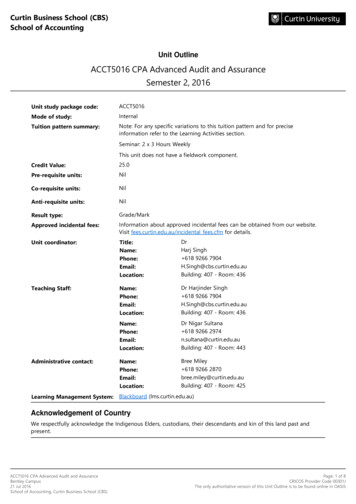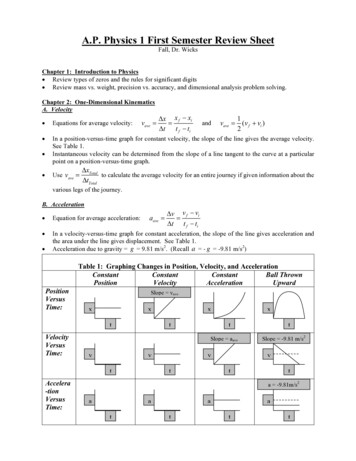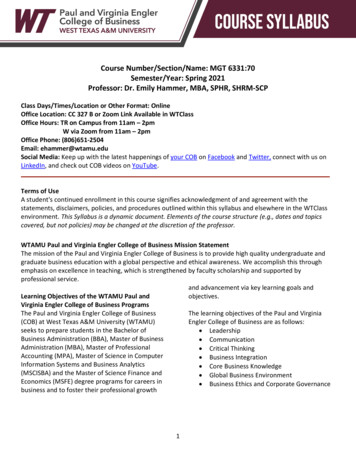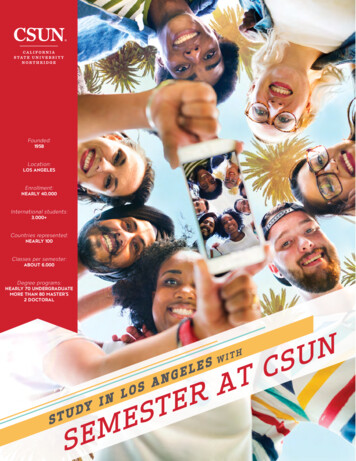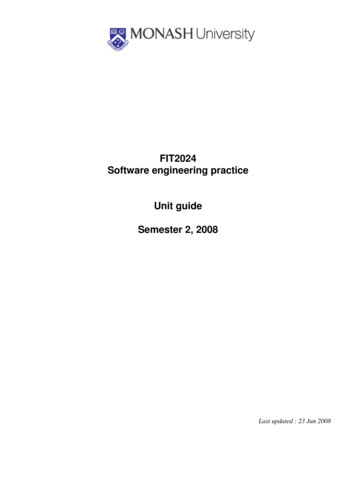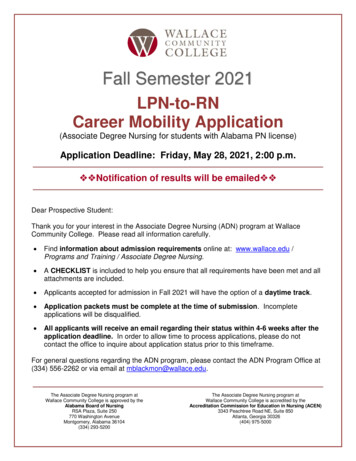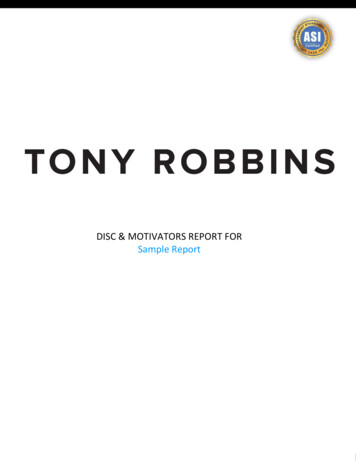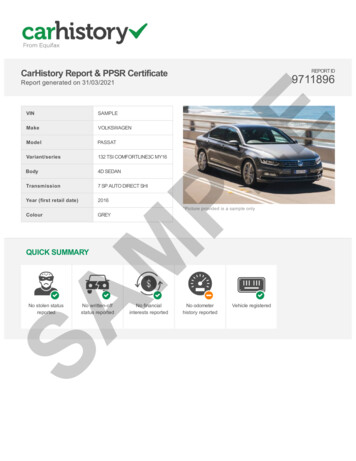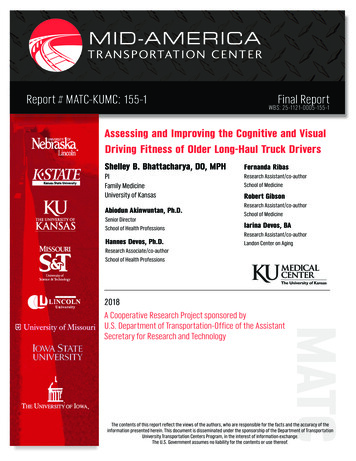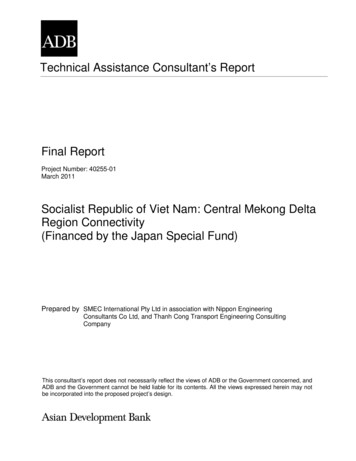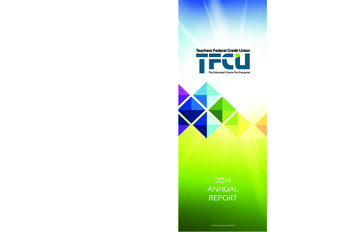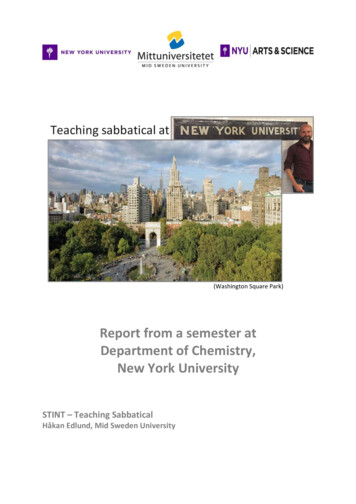
Transcription
(Washington Square Park)Report from a semester atDepartment of Chemistry,New York UniversitySTINT – Teaching SabbaticalHåkan Edlund, Mid Sweden University
IntroductionAs a part of the Teaching Sabbatical program founded and financed by STINT - The SwedishFoundation for International Cooperation in Research and Higher Education I had the opportunity toBe a visiting professor at the Department of Chemistry, Faculty of Arts & Science, New YorkUniversity. This final report cover my experiences the fall semester of 2017.New York UniversityFounded in 1831, New York University, NYU, is the largest private university in the United States.NYU present them self as two triangles, the three campuses in New York City, “the inner triangle”, atWashington Square Park, in Brooklyn (Tandon School of Engineering) and the Langone MedicalCenter on 1st Ave (School of Medicine and the Hospitals Center). The outer triangle is of course NewYork as the main hub, and the degree-granting campuses in Abu Dhabi (since 2010), and Shanghai(since 2013), they do also operate 11 global academic centers (one in Washington DC).The student body is more than 58,000 students, with more than 19,000 employees.The full-time faculty consists of 5,000 (of which 3,700 are Tenured and tenure-track).In the fall of 2015, there were 58,400 students (28,300 Undergraduates, 24,600 Graduateand Professional students: and 5,500 Noncredit Programs students including Employers-DegreePrograms and Employers-Diploma Programs). Housing for more than 11,000 undergraduate,graduate and professional students. (Undergraduate tuition fees 49,000 (2016-2017).The total budget for the fiscal 2017 (September 1 2016 to August 31 2017) is 3.10 billion apart fromthe Medical Center, ( 9.44 billion including the Medical Center). Total research expenditures was 700 million.Faculty of Arts & Science, the core body of the old University has three divisions or “sub-faculties”,Humanities, Science and Social Sciences, working together in the College of Arts and Science (CAS)for the undergraduates, 7484 students, and the Graduate School of Arts and Science (GSAS), 3885students. More than 30 departments and they also divide into more than 50 Research Centers andInstitutes.Department of Chemistry, Majors in chemistry and biochemistry, major in global publichealth/science with a concentration in Chemistry, Double Majors in chemical and bimolecularengineering and of course minor in chemistry.25 faculty professors (research professors, tenured), 20 clinical professors (teaching responsibilities),3 research scientists, 10 administration, 6 9 teaching & research lab support services, and more than100 graduate students. Larges classes are general chemistry with more than 500 students.
Preparation and planningThe preparation and planning activities started almost immediately after receiving the positivemessage a few days before Christmas 2016. My initial academic contact was the head of thedepartment, professor Jim Canary. After an iterative process, we had more or less decided on mymajor tasks and responsibilities and on dates for my planning trip.During my visit in the spring, I was scheduled to meet the director of undergraduate studies,professor Alexej Jerschow. He was also a colleague and the person I borrowed “my” course from. Ihad also the opportunity to meet a few other of the faculty members. One was Stefano Sacanna whohad an equivalent course during the spring semester so I could attend two lectures during myplanning trip to get some ideas for “my” future course and that was very helpful. A second importantperson I met was John Halpin, a clinical professor, responsible for the general chemistry course andreceived the 2017 Distinguished Teaching Award, New York University's highest honor for teaching.The faculty members who is not doing any research and have 100% teaching responsibilities arecalled clinical professors.Another important issue to deal with was housing. Me and my spouse was very early on searching forhousing and during my planning trip I did schedule to meet our landlord and check out theapartment that we did find through Airbnb and signed early on. This is important and could be atricky thing because NYU did not help in any way, even though they have over 1000 apartments forfaculty employees in the heart of Manhattan. We ended up on the New Jersey side of Hudson River,very convenient even if it was not Greenwich Village that we did aim for in the first place. My dailycommuting to the university was very easy-going, it took 25 minutes door-to-door including a ridewith an equivalent to the subway system passing under the river (PATH), and that wasn t bad.Tasks and responsibilitiesMy main task and responsibility was teaching one of the physical chemistry courses CHEM-UA 652:Thermodynamics and Kinetics. AT NYU the chemistry courses was divided in theoretical courses andlab courses. Physical chemistry had two theoretical courses and one laboratory course covering thetwo theoretical ones. I will come back to the fact that I (the teacher) was completely responsible forthe course. The course was one of six mandatory chemistry courses for chemistry majors at NYU andwas taught every semester. In addition, students aiming for the graduate school of medicine didattend the course. During the semester, I had one PhD-student helping with recitation hours andwith some of the homework and quiz grading. I did teach two 75 minutes lectures every week exceptthose weeks when we had the first and second midterm exam because they were scheduled onordinary lecture time. I did also have scheduled office hours. I like the concept of office hours whenthe students have opportunity to get personal tutorials and ask in-depth questions about things thatare confusing or maybe not addressed fully in class.
Activities during the semesterMy first activity outside the department was an introductory course, NYU Classes Training session,The NYU Classes was the learning management system used at NYU. Here students accessed coursematerials and the different graded assignments and exams was shown.I visited classes given by other faculty members at the department, one class was particularlyinteresting to follow, professor John Halpin lecturing the general chemistry course for 550 studentsstill able to interact with the students during class. He did use “clickers”, a classroom responsesystem, that all students bought before class. Professor Halpin had all his lecture notes writtenbefore the course starts as a part of the reading material bought.I attended a series of seminars from the NYU Center for Advancement of Teaching; one title wasWhat Makes a Great Teacher? A Discussion with 2016-2017 Distinguished Teaching Awardees. JohnHalpin from Chemistry was one in the panel.I am interested in the extensive program in undergraduate research that is well developed in the US.I did interview both professors and students about the undergraduate research program/coursesthey had at NYU.One other thing that I was able to follow during my stay was different New Faculty (starting on thetenure-track system) orientation activities. They really emphasized this through meetings andseminars: facts&figures, learning about the tenure track system, NYU s non-discrimination and antiharassment policy & compliance, Title IX. What to do in the classroom when unexpected thingshappens, where to send students that didn t feel well of different reasons, etc.I gave a seminar about my research in a Chemistry Roundtable event; a professor and a graduatestudent in the chemistry department give a presentation about their research to undergraduatestudents. That was a popular event done twice a semester.Together with the head of the department, I arranged an afternoon seminar and discussion towardsthe end of my stay. The seminar focused on my experiences as a scholar on a teaching sabbatical. Istarted with a 45 minutes presentation “The education system, differences and similarities, teachingundergraduate chemistry at the university level, a Swedish viewpoint” and then questions anddiscussions about pros & cons.
As a large research department, I had many possibilities to attend to research seminars, bothspecialized and more general ones.At last I must say that the university, faculty and department was good in having different events aswelcome breakfast, new faculty welcome reception (with the president of NYU), InternationalFaculty and Research Scholar Reception, Scholar speaker series, Christmas party for the department(with the president), Christmas party for the faculty They did also arrange a program called International Spouses & Partners Programs, includingwelcome breakfast and different trips and a conversational English course where thespouses/partners were placed on their level of knowledge in English (International Spouse/PartnerEnglish Program (ISEP)).Important lessonsIt was not that easy to get contact with the different faculty members. One thing is that thedepartment didn t have any natural places for informal meetings as coffee hours, the Swedish fika isfantastic, or places to gather to eat your packed lunch at have some conversation. The doors to theoffices were always closed and you needed to contact different faculty members and ask for lunchesand meetings.Comparison between the foreign and the home institutionsStudent population: NYU has grown the last years due to two new global campuses and a polytechnicschool) and today they are almost 60 000 students compared to 13 000 at Mid Sweden University.The relation between research and education: In Sweden it could be very different teaching loads forprofessors depending on research sources but at NYU all research professors had the same amountof teaching, one course per semester, “you didn t pay yourself free” even if you had a lot of researchgrants. The department did also have clinical professors who did just do teaching and they weresupposed to have three ordinary sized classes per semester. When I talked about “tjänsteplanering”they did not understand what I was talking about because the tenured track professors where fullypayed by the faculty and never calculating working hours.The relation between teacher and students: It was hierarchical and with a professional distancebetween professors and students but at the same time a very friendly atmosphere. I think that theprofessors at NYU are more demanding and at the same time they were more caring about theindividual student s learning and they had a very good control of the individual students efforts. Thestudents was used to get direct and constructive critics depending on performance.
The institution’s view of breadth versus specialization in education: There is a huge difference in theview of breadth versus specialization but some of that difference is a fact that the bachelor programin Sweden is three years and in the US, it is four years. The students could both aim for a minor in adifferent subject but also have the opportunity to study both social sciences and humanities.Competence development for teachers: There was not any mandatory development path for thetenure track members at NYU but teachers at the department had the possibility to participate onthe broad variety of courses, workshops and seminars held by the Center for the advancement ofteaching. To name a few events, Teaching Lunch Programs (offer practical resources to enhanceteacher effectiveness in the classroom), Teaching Intensive Workshops (workshops focusing onpractical aspects of teaching, such as using technology, designing syllabi, and leading classdiscussions), Teaching at the Tap Room (is a chance for faculty to come together to discusspedagogical issues with experts and peers alike in an informal and relaxed setting) and differentTeaching conferences focusing on areas of interest to the teaching community. One other interestingopportunity is the Teaching Consultation Services schedule a consultation on any aspect of yourteaching or to arrange a classroom observation.Teacher recruitment: I talked to the head of the department about their recruitment and recruitmentstrategies. Last year they did try to recruit 4-5 new faculty but after the application and evaluationprocess they thought that only two (out of 80) was suitable for the tenure track system. This year theaim was 3-4 new faculty members and the process was ongoing during the fall. All new recruitmentsat the college of Art&science did start at the same time (late august).At NYU, teachers are completely responsible in a more direct way then in Sweden. Some things wasdecided on a very early basis as when and how long the lectures was supposed to be, when therecitations was supposed to be (attended by a PhD-student as a TA, teaching assistant). Furthermore,we had office hours and these I had to set but I did decide on how many and when. The date, timeand length for the final exam was also set. Two month before the course started, they asked meabout what literature I would like to use.Three large differences: The most surprising thing was that I was supposed to write my own course plan (syllabus). Aswe know in Sweden, it is a rigorous path writing a new course plan especially when it is apart of a program. Decisions at different levels of our administration, here the course couldchange every year depending on the professor. In the syllabus, I did present my aim of thecourse and the different exam methods (quizzes, homework and written exams). I alsodecided how the different examining moments should be weighed against each other beforethe grading. The course had unprepared small tests (quizzes), homework questions to behanded in and three exams (2 midterms and a final). I also decided rules for missed examinations. E.g., I had three exams during the course and ifyou missed one of the two midterms, you could drop it if you had a medical certificate. Allresults were counted against the final grade and there were no excuses. Moreover, I was responsible and decided if the student had the possibility to make a “makeup” exam at the final exam.The last and very important task was the grading of the final exam and editing the course grades intotheir system. After the exam was given, I had 72 hours to grade the final exam and then decide uponthe course grade. On the other hand, you did know about the date for the final exam one year inadvance, so no meetings, conferences or holiday plans during those three days.Action plan – topics to address and if possible introduce in SwedenI have not been home for so long but I have had time to discuss with colleagues and present myexperiences at a departmental staff meeting.
For some time we have been talking about undergraduate research and planned for introducing thatin our new chemical engineering program at MIUN. I think my discussions at NYU during the fall canbe important in the future developments of new courses and improvements of the newly launchedcourse at MIUN.One thing I have reflected during the fall is the introduction and welcoming of new employees. Theintroduction program at NYU is of course difficult to copy but it was very extensive and kept going formore than a year. I think that we can do more and better at my home institution. It is too easy to beleft alone as a new faculty and the university missing out the possibility to create a feeling ofresponsibility for the quality of the university. I also think of my own welcome and that I will be muchbetter caring for the newly employed and presenting myself, it is so easy that the responsible formandatory walking around with new employees miss presenting all staff.At last, I would like to express my gratitude to Mid Sweden University and STINT for this opportunity,giving me experiences that will influence my life both private and as a faculty member for many yearsto come.Thank you / Håkan
Professor Halpin had all his lecture notes written before the course starts as a part of the reading material bought. I attended a series of seminars from the NYU Center for Advancement of Teaching; one title was What Makes a Great Teacher? A Discussion with 2016-2017 Distinguished Teaching Awardees.
